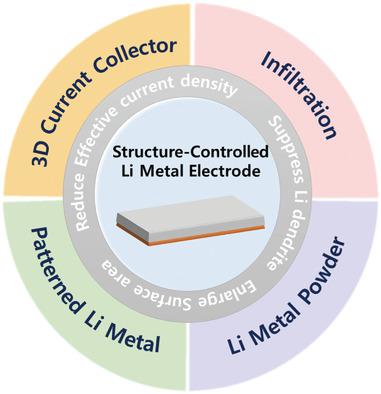当前位置:
X-MOL 学术
›
Adv. Mater. Interfaces
›
论文详情
Our official English website, www.x-mol.net, welcomes your
feedback! (Note: you will need to create a separate account there.)
Structure‐Controlled Li Metal Electrodes for Post‐Li‐Ion Batteries: Recent Progress and Perspectives
Advanced Materials Interfaces ( IF 4.3 ) Pub Date : 2020-02-23 , DOI: 10.1002/admi.201902113 Dahee Jin 1 , Joonam Park 1 , Myung‐Hyun Ryou 2 , Yong Min Lee 1
Advanced Materials Interfaces ( IF 4.3 ) Pub Date : 2020-02-23 , DOI: 10.1002/admi.201902113 Dahee Jin 1 , Joonam Park 1 , Myung‐Hyun Ryou 2 , Yong Min Lee 1
Affiliation

|
Li dendrite formation deteriorates cyclability and poses a safety hazard, hindering the widespread use of Li metal as the ultimate anode material for post‐Li‐ion batteries. Hence, the underlying reasons of this phenomenon and ways to suppress it have been extensively investigated, which has resulted in the establishment of corresponding theoretical models and their practical applications. Herein, several representative models (e.g., the Chazalviel model) of Li dendrite growth are explained, and the key technologies of structure‐controlled framework and Li metal usage allowing to realize low local current densities and improved electrochemical performance are covered with the practical (dis)advantages due to material characteristics, electrode and cell design, and even manufacturing processes. In particular, the use of Li metal powder and patterned Li metal is discussed in conjunction with corresponding applications (e.g., protection layers, functional additives, and salts in the electrolyte) and advantages.
中文翻译:

后锂离子电池的结构控制锂金属电极:最新进展和展望
锂枝晶的形成会降低循环性并带来安全隐患,从而阻碍了锂金属作为后锂离子电池最终阳极材料的广泛使用。因此,对该现象的根本原因及其抑制方法进行了广泛的研究,从而建立了相应的理论模型及其实际应用。本文解释了锂枝晶生长的几种代表性模型(例如,Chazalviel模型),并且结构控制框架和锂金属使用的关键技术可实现较低的局部电流密度和改善的电化学性能,涵盖了实用的(dis )由于材料特性,电极和电池设计甚至制造工艺而带来的优势。尤其是,
更新日期:2020-02-23
中文翻译:

后锂离子电池的结构控制锂金属电极:最新进展和展望
锂枝晶的形成会降低循环性并带来安全隐患,从而阻碍了锂金属作为后锂离子电池最终阳极材料的广泛使用。因此,对该现象的根本原因及其抑制方法进行了广泛的研究,从而建立了相应的理论模型及其实际应用。本文解释了锂枝晶生长的几种代表性模型(例如,Chazalviel模型),并且结构控制框架和锂金属使用的关键技术可实现较低的局部电流密度和改善的电化学性能,涵盖了实用的(dis )由于材料特性,电极和电池设计甚至制造工艺而带来的优势。尤其是,











































 京公网安备 11010802027423号
京公网安备 11010802027423号